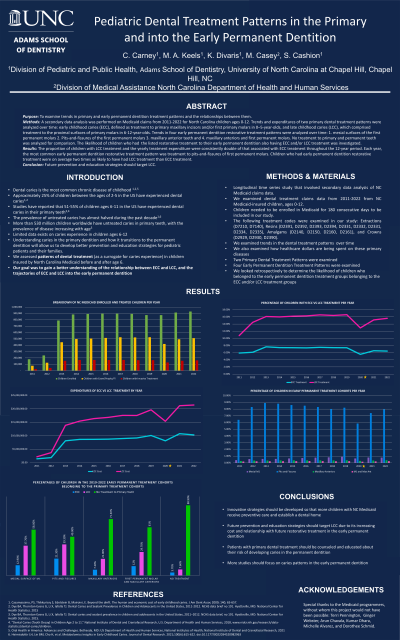Caries
130 - Pediatric Dental Treatment Patterns in the Primary and into the Early Permanent Dentition


Claire Carney, DDS
Resident
University of North Carolina, Chapel Hill, NC
UNC Adams School of Dentistry
Chapel Hill, North Carolina, United States- SC
Scott Cashion, DDS, MS
UNC Adams School of Dentistry
- MK
Martha Ann Keels, DDS, PhD
UNC Adams School of Dentistry
- MC
Mark Casey, DDS, MPH
State of North Carolina Department of Health and Human Services
- KD
Kimon Divaris, DDS, PhD
UNC Adams School of Dentistry
- MK
Martha Ann Keels, DDS PhD
Adjunct Professor, Pediatric Dentistry
UNC Adams School of Dentistry
Durham, North Carolina, United States - SC
Scott W. Cashion, DDS, MS
Associate Professor
University of North Carolina at Chapel Hill
Chapel Hill, North Carolina, United States
Presenting Author(s)
Co-Author(s)
Research Mentor(s)
Program Director(s)
Purpose: To examine trends in primary and early permanent dentition treatment patterns and the relationships between them.
Methods: A secondary data analysis was performed on Medicaid claims from 2011-2022 for North Carolina children ages 0-12. Trends and expenditures of two primary dental treatment patterns were analyzed over time: early childhood caries (ECC), defined as treatment to primary maxillary incisors and/or first primary molars in 0–5-year-olds, and late childhood caries (LCC), which comprised treatment to the proximal surfaces of primary molars in 6-12-year-olds. Trends in four early permanent dentition restorative treatment patterns were analyzed over time: 1. mesial surfaces of the first permanent molars 2. Pits-and-fissures of the first permanent molars 3. maxillary anterior teeth and 4. maxillary anteriors and first permanent molars. No treatment to primary and permanent teeth was analyzed for comparison. The likelihood of children who had the listed restorative treatment to their early permanent dentition also having ECC and/or LCC treatment was investigated.
Results: The proportion of children with LCC treatment and the yearly treatment expenditure were consistently double of that associated with ECC treatment throughout the 12-year period. Each year, the most common early permanent dentition restorative treatment pattern was treatment to pits-and-fissures of first permanent molars. Children who had early permanent dentition restorative treatment were on average two times as likely to have had LCC treatment than ECC treatment.
Conclusion: Future prevention and education strategies should target LCC due to its increasing cost and relationship with future restorative treatment in the early permanent dentition.
Identify Supporting Agency and Grant Number: N/A

.jpg)